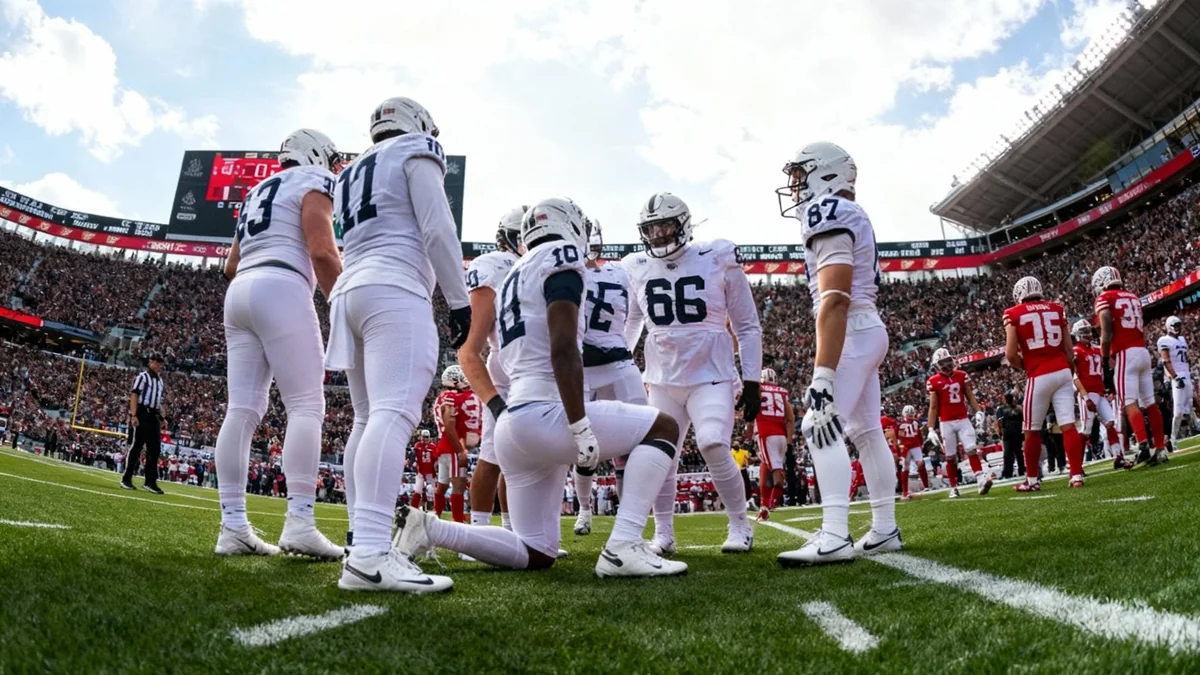Penn State is adjusting its offensive strategy to better utilize running back Nick Singleton, shifting his role to include more plays in open space and the passing game. The change was evident during the Nittany Lions' 38-14 loss to Ohio State, where Singleton led the team in receiving yards despite limited rushing attempts.
This strategic pivot comes during a season where Singleton's traditional rushing numbers have not met preseason expectations. Coaches have indicated that involving him more on the perimeter will be a key focus for the remainder of the season as they look to energize the offense.
Key Takeaways
- Penn State is increasingly using running back Nick Singleton in the passing game and on perimeter runs.
- Against Ohio State, Singleton had the most receiving yards for the Nittany Lions with 28 yards on three catches.
- The adjustment comes as Singleton's rushing production has dipped, with only six rushing attempts in each of the last two games.
- Interim head coach Terry Smith confirmed that getting Singleton the ball in space is a "point of emphasis" for the offense moving forward.
A Season of Unexpected Challenges
Entering the 2025 season, expectations were high for Nick Singleton. Many, including the running back himself, anticipated a run at the program's career rushing record held by Evan Royster. However, the season has presented challenges for the entire offense, and Singleton's production has been affected.
With only five games left in the season, Singleton has accumulated 292 yards on the ground. He remains 728 yards short of Royster's record, a gap that would require an average of 145.6 rushing yards per game to close—a difficult task under any circumstances.
By the Numbers: Singleton's Season
- Total Rushing Yards: 292
- Yards Needed for Record: 728
- Rushing Attempts vs. Ohio State: 6
- Recent Touchdowns: 2 in the last 5 games
The dip in traditional rushing numbers has led the coaching staff to re-evaluate how to best leverage his talents. In the past two games, his number of carries has been intentionally limited to just six per contest, signaling a clear shift in offensive design.
New Role Showcased Against Ohio State
The game against Ohio State served as a public demonstration of Penn State's new approach. While the outcome was a loss, Singleton's usage provided a glimpse into the team's offensive future. He was a primary target in space, finishing with three catches for 28 yards, which led the team.
This strategy was most effective on Penn State's first scoring drive. Singleton was directly involved in five plays, accumulating 42 total yards and capping the drive with a touchdown. It was his first score since the game against Northwestern and just his second in the team's last five outings.
"It felt good, obviously, to get back in the end zone, you know, doing stuff for my team," Singleton said after the game. "I’m just upset we lost, but you gotta keep moving through it and just get better."
Despite the success of that drive, his involvement waned. After the touchdown, Singleton only touched the ball four more times for the remainder of the game, including three runs up the middle and one reception that resulted in a loss of a yard.
Coaching Staff Commits to the Adjustment
The Nittany Lions' coaching staff has been open about the need to get Singleton more involved. Offensive coordinator Andy Kotelnicki noted during the team's bye week that getting Singleton runs on the perimeter was a priority to take advantage of his speed and athleticism.
Interim head coach Terry Smith echoed this sentiment following the Ohio State game, confirming the intentionality behind the game plan.
"That was a point of emphasis as well in the game, try to get Nick going," Smith stated. "He's one of our top two guys to touch the ball... We have to keep him involved in the offense. He's a major part of it, and that will be a point of emphasis going forward."
This strategic shift also acknowledges Singleton's development as a pass-catcher, an area he worked to improve significantly last season. His reliability as a receiver provides the offense with a much-needed dynamic option.
Mental Fortitude Amidst Change
For Singleton, the season's trajectory has been a mental test. Adjusting from being a primary ball carrier to a more versatile offensive weapon requires a different mindset. "It's been a little hard," Singleton admitted. "But at the same time being here for my teammates, for myself, the coaches, just taking one week at a time. Whenever I get in the game, I make it happen.”
Looking Ahead: An Offense in Transition
As Penn State moves into the final stretch of its season, the evolution of Singleton's role will be a key storyline. The offense has struggled to find consistent rhythm, and effectively using one of its most explosive players could be the key to unlocking its potential.
Teammates also see the value in the new approach. Quarterback Ethan Grunkemeyer highlighted how dangerous Singleton can be when he is not confined to running between the tackles.
"You see him, whether it's him catching the ball or getting a run out in space,” Grunkemeyer said. “That's when he's at his most dangerous. So the more we can do that with him, I think that's the best he'll be.”
The commitment from the coaching staff suggests that fans can expect to see Singleton featured more frequently on screen passes, swing routes, and outside runs, as Penn State attempts to salvage its season by adapting its offense around the unique skills of its star player.





